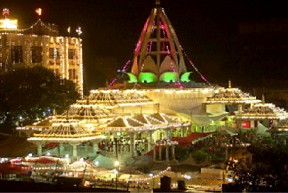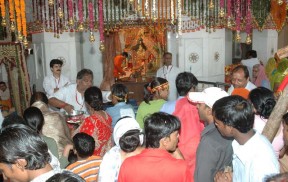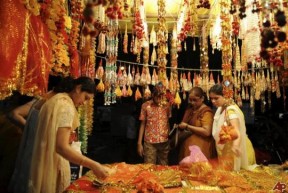 During Navratri, the nine-day festival of the Mother Goddess, the entire five-mile radius around the Jhandewalan temple complex on Rani Jhansi Road in central Delhi is a beehive of activity round-the-clock, giving a whole new meaning to the term, ‘the city never sleeps’! The sight of the affluent in all their finery, arriving in large flashy cars, standing in miles-long queues and rubbing shoulders with equally devout dwellers of the surrounding slums also demonstrates like nothing else can, that in the eyes of the Almighty everyone is equal!
During Navratri, the nine-day festival of the Mother Goddess, the entire five-mile radius around the Jhandewalan temple complex on Rani Jhansi Road in central Delhi is a beehive of activity round-the-clock, giving a whole new meaning to the term, ‘the city never sleeps’! The sight of the affluent in all their finery, arriving in large flashy cars, standing in miles-long queues and rubbing shoulders with equally devout dwellers of the surrounding slums also demonstrates like nothing else can, that in the eyes of the Almighty everyone is equal!
Festivals in Delhi are an experience unlike any other—the name of the festival, the religion it stems from, the region or community that claims ‘ownership’ of it are irrelevant details. Dilliwalas just need a reason to celebrate, and what better reason than a festival? And what could lend itself better to pomp and splendour, than Navratri?
The past two decades have seen Delhi transform from a bastion of austere sophisticates and wannabe sophisticates whose festival celebrations are carried out in hushed tones, muted colours and decorous gatherings, to a stronghold of unabashedly exuberant immigrants who have adopted the city as their own and have become part of its fibre, painting it in bold, bright colours of their multi-cultural existence. To this potent mix has been added the culture of family-based soap operas on television, where the celebration of every festival is extremely ‘filmy’ and larger than life. And the result has been an explosion of light, colour and sound—not to mention nightmarishly congested roads and markets—and when it’s a nine-day festival , the happy chaos has to be seen to be believed.
 At the Jhandewalan temple, during Navratri, devotees start lining up for darshan from the wee hours, into queues that snake around the complex for miles and go on late into the night. The temple is situated at a stone’s throw from Connaught Place, the largest and busiest commercial centre of the Capital—in the heart of Delhi, as it were. Thus, the entire area, five miles around the temple in every direction, is set up with barricades and sandbags for snipers, days in advance of Navratri, to provide for crowd related contingencies. Alleyways of bamboo poles and corrugated metal sheets are constructed on the pavements for miles outside the temple complex to keep the throngs of devotees moving in ordered lines and prevent them from either stampeding or blocking some of the busiest thoroughfares of the Capital.
At the Jhandewalan temple, during Navratri, devotees start lining up for darshan from the wee hours, into queues that snake around the complex for miles and go on late into the night. The temple is situated at a stone’s throw from Connaught Place, the largest and busiest commercial centre of the Capital—in the heart of Delhi, as it were. Thus, the entire area, five miles around the temple in every direction, is set up with barricades and sandbags for snipers, days in advance of Navratri, to provide for crowd related contingencies. Alleyways of bamboo poles and corrugated metal sheets are constructed on the pavements for miles outside the temple complex to keep the throngs of devotees moving in ordered lines and prevent them from either stampeding or blocking some of the busiest thoroughfares of the Capital.
The name’ Jhandewalan’ was bestowed upon this shrine of the Goddess Shri Aadi Shakti during Shah Jahan’s reign, and derives from the tradition of offering prayer flags or ‘jhandas‘ to the diety. This ancient temple has a subterranean shrine as well. The upper level of the temple houses an idol of the Goddess Jhandewali, along with those of other Gods. The original idol of the Goddess Jhandewali, however, stands in the subterranean shrine in solitary splendour.
 An interesting story connected to this temple is that Badri Bhagat, a great devotee of the Goddess in the twelfth century, had a dream in which she informed him of the whereabouts of this idol. Upon excavation, the idol was found on the exact spot, and is thus called ‘Swayambhu’ (an idol that has appeared out of the earth by declaring itself to mortals by divine means). Thus, the mystique associated with the temple, which, along with its antiquity, makes it a great draw for devotees of the Goddess, and especially so during the ‘days of the Goddess’, the Navratri.
An interesting story connected to this temple is that Badri Bhagat, a great devotee of the Goddess in the twelfth century, had a dream in which she informed him of the whereabouts of this idol. Upon excavation, the idol was found on the exact spot, and is thus called ‘Swayambhu’ (an idol that has appeared out of the earth by declaring itself to mortals by divine means). Thus, the mystique associated with the temple, which, along with its antiquity, makes it a great draw for devotees of the Goddess, and especially so during the ‘days of the Goddess’, the Navratri.
The entire temple complex hosts the ‘Jhandewali ka mela’ or the fair of the ‘Goddess of the Flags’. The atmosphere buzzes with innumerable stalls, not only of prayer-related materials and food, but also toys, books, clothing, jewellery and household appliances. There are also practitioners of Astrology, other occult sciences, natural healing, parallel therapies—in fact, everything under the sun that one can possibly think of!
All eating places in Delhi, almost without exception, be it roadside stalls, or sweet shops, or high-profile chains like Haldiram, Bikanerwala and Nathu, or even restaurants and hotels—serve ‘Navratri special’ food or ‘phalahaar’ for those who observe the Navratri fasts (and the number of Delhiites fasting is not a joke!)—food usually prepared from kuttu or singhada flour, potatoes, fruits and milk products, and seasoned with rock salt (sendha namak)—in fact, just yesterday, a young couple (the female half of whom was fasting) was overheard at an outlet of the Giani chain of ice cream parlours, asking whether they served any ‘vrat ice cream’ (special ice cream for those who were fasting)!
 And as the Navratri draws to a close, the markets are flooded with what shopkeepers quaintly refer to as ‘novelty items’ and what mothers of young daughters are wont to refer to as ‘rubbish to clutter the house’—gift items like fancy hairclips, colour sets, tiffin boxes, water bottles, pencil cases and other miscellaneous merchandise sporting the children’s favourite cartoon or TV soap characters—to be gifted to the ‘kanjaks’ or young girls who are worshipped as incarnations of the Goddess on the final day of Navratri. This is one day that little girls from Delhi’s slums have a field day, making the rounds of affluent colonies and hanging around outside temples in groups, dressed in their ‘best’, collecting goodies, gifts and money, for this is one day when no one will turn away the ‘Kanya Devis’ (little Goddesses)!
And as the Navratri draws to a close, the markets are flooded with what shopkeepers quaintly refer to as ‘novelty items’ and what mothers of young daughters are wont to refer to as ‘rubbish to clutter the house’—gift items like fancy hairclips, colour sets, tiffin boxes, water bottles, pencil cases and other miscellaneous merchandise sporting the children’s favourite cartoon or TV soap characters—to be gifted to the ‘kanjaks’ or young girls who are worshipped as incarnations of the Goddess on the final day of Navratri. This is one day that little girls from Delhi’s slums have a field day, making the rounds of affluent colonies and hanging around outside temples in groups, dressed in their ‘best’, collecting goodies, gifts and money, for this is one day when no one will turn away the ‘Kanya Devis’ (little Goddesses)!





